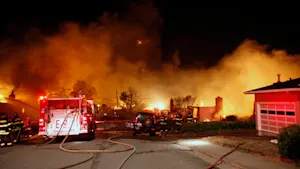More Stories
Electric vehicles are exploding in popularity these days, but when accidents happen - as they often do - first responders are facing challenges they've never experienced before, that could prove deadly.
News 12's Tara Rosenblum has the information you need to stay safe in electric cars.
When a car erupts in flames, most firefighters have their response down to a science. They know exactly what to do and when.
But, if that car happens to be an electric vehicle, they have to pivot quickly and take a whole new approach because of the lithium batteries that power them.
MORE: Turn to Tara
They're not easy to get at - they are made up of 1,000 cells in a compartment underneath the vehicle.
So, when they catch fire, access can be really challenging, allowing the batteries to burn hotter and faster and even reignite, requiring a whole lot of water to extinguish them.
A typical standard car gets 300 to 500 gallons of water, but electric vehicles take thousands -- which was the case when bad weather sent a Tesla smashing into a tree on the Palisades Parkway earlier this year, instantly killing the driver. The vehicle's lithium battery also ruptured, sparking a fire that responders struggled to contain.
A standard firefighter engine only contains 500 to 750 gallons of water.
Electric vehicles are exploding in popularity, with just under 52,000 of them on the road in New York, nearly 48,000 in New Jersey and just over 13,000 in Connecticut.
Despite that, data from the National Transportation Safety Board uncovered by the Turn to Tara team shows a third of the nation's fire departments are ill-prepared to respond to electric vehicle fires because of a lack of hands-on-training, leaving many responders to educate themselves using the response guides published directly by the car-makers.
While Tesla did not return News 12's calls for comment, it is important to point out, that despite the challenges firefighters are facing, so far, research from the Highway Loss Data Institute shows that drivers are no less safe driving in a Tesla than a regular car.
To cut down the risk of a fire, follow these tips:
- Figure out where your electric main shut-off switch is - don't wait for a crash.
- Always be on the look out for any strange odors coming from car.
- Remember to charge your vehicles outside your garage - you rather have the vehicle or fire outside your house as opposed to inside your garage.
Got a problem? You should Turn to Tara. HERE'S HOW.
More from News 12
1:31

What's Cooking: Uncle Giuseppe's Marketplace's prime rib roast
1:27

What's Cooking: Uncle Giuseppe's quiche lorraine
2:34

Guide: Safety tips to help prevent home burglaries
2:19

Guide: Safety measures to help prevent fires and how to escape one
2:07

Tips on how to avoid confrontation with sharks while swimming in the ocean
2:33
